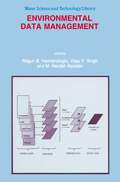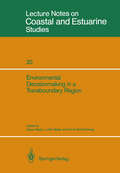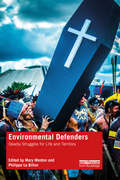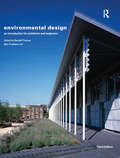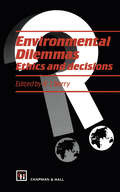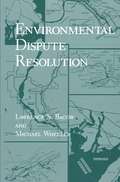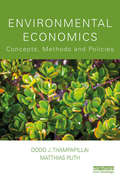- Table View
- List View
Environmental Damage to DNA and the Protective Effects of Phytochemicals
by Bechan Sharma Nitika SinghEnvironmental Damage to DNA and the Protective Effects of Phytochemicals provides information on the toxicity of natural as well as synthetic chemicals in the living systems. These can lead to DNA damage and the emergence of serious consequences or manifestations causing varied health hazards. In addition, the ten chapters of the book reflect on the possible applications of plants or plant extracts to impart protection for living cells from the xenobiotics-mediated DNA damage. The book offers comprehensive coverage of the many essential topics in the subject including: Environmental factors and DNA damage Molecular mechanisms associated with DNA damage by various environmental (Physical, Chemical and Biological) factors Synergistic effects of environmental factors Phytochemicals acting both as DNA protectants and genotoxicants Experimental models for the study of the genotoxic potential of environmental factors and protection by phytochemicals This book connects readers who possess a life sciences background to the current understanding, concept and mechanisms involved in environmental-factors-mediated DNA damage. Scientific terms are introduced, defined, described and placed appropriately in the text. The protective effect of some plant extracts/phytochemicals has also been included. Environmental Damage to DNA and the Protective Effects of Phytochemicals is intended to cater the need of BSc, MSc and research students who are striving to discover the mechanism(s) associated with protection of DNA by plant-based chemicals. This is the first edition of our book and the valuable suggestions and comments from the readers are solicited.
Environmental Data Analysis: An Introduction with Examples in R
by Carsten DormannEnvironmental Data Analysis is an introductory statistics textbook for environmental science. It covers descriptive, inferential and predictive statistics, centred on the Generalized Linear Model. The key idea behind this book is to approach statistical analyses from the perspective of maximum likelihood, essentially treating most analyses as (multiple) regression problems. The reader will be introduced to statistical distributions early on, and will learn to deploy models suitable for the data at hand, which in environmental science are often not normally distributed. To make the initially steep learning curve more manageable, each statistical chapter is followed by a walk-through in a corresponding R-based how-to chapter, which reviews the theory and applies it to environmental data. In this way, a coherent and expandable foundation in parametric statistics is laid, which can be expanded in advanced courses.The content has been “field-tested” in several years of courses on statistics for Environmental Science, Geography and Forestry taught at the University of Freiburg.
Environmental Data Management (Water Science and Technology Library #27)
by V. P. SinghThe diverse nature of environmental problems mankind has encountered within the last decade has developed a new understanding of the nature of environmental processes. Currently, the environment is considered as a continuum of air, soil and water as the vital components for sustaining life on earth. The interactive nature of these components requires that the environment is managed and protected as a cohesive whole. This can only be accomplished through an integrated approach to environmental management. Besides the concept of environmental continuum, prospects for sustainable development of natural resources and the recent recognition of global climate change impacts have also necessitated such an integrated approach to environmental management. Two basic tools for integrated management of the environment are modeling and environmental data. Both tools were available and valid in the past; however, the recent requirements for integrated environmental management have also led to a significant evolution of both modeling procedures and data management systems.
Environmental Decisionmaking in a Transboundary Region: (pdf) (Coastal and Estuarine Studies #20)
by Alison Rieser Judith Spiller David VanderZwaagEnvironmental Defenders: Deadly Struggles for Life and Territory (Routledge Explorations in Environmental Studies)
by Mary Menton; Philippe Le BillonThis book is about environmental defenders and the violence they face while seeking to protect their land and the environment. Between 2002 and 2019, at least two thousand people were killed in 57 countries for defending their lands and the environment. Recent policy initiatives and media coverage have provided much needed attention to the protection and support of defenders, but there has so far been little scholarly work. This edited volume explains who these defenders are, what threats they face, and what can be done to help support and protect them. Delving deep into the complex relations between and within communities, corporations, and government authorities, the book highlights the diversity of defenders, the collective character of their struggles, the many drivers and forms of violence they are facing, as well as the importance of emotions and gendered dimensions in protests and repression. Drawing on global case studies, it examines the violence taking place around different types of development projects, including fossil fuels, agro-industrial, renewable energy, and infrastructure. The volume also examines the violence surrounding conservation projects, including through militarized wildlife protection and surveillance technologies. The book concludes with a reflection on the perspectives of defenders about the best ways to support and protect them. It contrasts these with the lagging efforts of an international community often promoting economic growth over the lives of defenders. This volume is essential reading for all interested in understanding the challenges faced by environmental defenders and how to help and support them. It will also appeal to students, scholars and practitioners involved in environmental protection, environmental activism, human rights, social movements and development studies.
Environmental Defenders: Deadly Struggles for Life and Territory (Routledge Explorations in Environmental Studies)
by Mary Menton Philippe Le BillonThis book is about environmental defenders and the violence they face while seeking to protect their land and the environment. Between 2002 and 2019, at least two thousand people were killed in 57 countries for defending their lands and the environment. Recent policy initiatives and media coverage have provided much needed attention to the protection and support of defenders, but there has so far been little scholarly work. This edited volume explains who these defenders are, what threats they face, and what can be done to help support and protect them. Delving deep into the complex relations between and within communities, corporations, and government authorities, the book highlights the diversity of defenders, the collective character of their struggles, the many drivers and forms of violence they are facing, as well as the importance of emotions and gendered dimensions in protests and repression. Drawing on global case studies, it examines the violence taking place around different types of development projects, including fossil fuels, agro-industrial, renewable energy, and infrastructure. The volume also examines the violence surrounding conservation projects, including through militarized wildlife protection and surveillance technologies. The book concludes with a reflection on the perspectives of defenders about the best ways to support and protect them. It contrasts these with the lagging efforts of an international community often promoting economic growth over the lives of defenders. This volume is essential reading for all interested in understanding the challenges faced by environmental defenders and how to help and support them. It will also appeal to students, scholars and practitioners involved in environmental protection, environmental activism, human rights, social movements and development studies.
Environmental Degradation: Challenges and Strategies for Mitigation (Water Science and Technology Library #104)
by Vijay P. Singh Shalini Yadav Ram Narayan Yadava Krishna Kumar YadavThis book discusses problems, challenges, and mitigation strategies in the wake of environmental degradation. It suggests proactive solutions to problems of environmental degradation for strategic planning as well as their effective delivery, and problems arising due to growth in population, industry, and land use change. The uniqueness of the book is its broader spectrum of coverage with related interconnections and interdependence of various aspects. Presenting a wide spectrum of viewpoints and approaches, the book covers topics, such as deforestation impacts (land use and land cover, soil erosion); impacts on climate change and human health; treatment of industrial, municipal, biological waste disposal and their impacts on soil, water, and air; recovery/remediation processes and technologies; impacts of pesticides and chemical fertilizers on soil degradation and groundwater; socio-economic environmental sustainability; and socio-economic health impacts. Particular focus is placed on strategic planning and methodological handling of environmental degradation and remediation through various processes and treatment technologies. This book will be useful to researchers, professionals, policy makers, and environmental engineers.
Environmental Degradation: Monitoring, Assessment and Treatment Technologies
by Izharul Haq Ajay S. Kalamdhad Siddhant DashThis book focuses on municipal and industrial water and wastewater treatment technologies. The chapters provide detailed information about wastewaters' occurrence, source, characteristics, toxicity, and conventional and advanced treatment process. In addition, the book presents chapters relating to different monitoring methods adopted for water quality assessment in different water bodies. This book aims to boost the knowledge of students, researchers, scientists, professors, engineers and professionals who aspire to work in the field of environmental science, environmental biotechnology, environmental microbiology, civil/environmental engineering, eco-toxicology and other relevant areas of industrial waste management for the safety of the environment. The readers of the book will obtain valuable information related to various environmental problems and their solutions.
Environmental Degradation of Advanced and Traditional Engineering Materials
by Lloyd H. Hihara Ralph P. I. Adler Ronald M. LatanisionOne of the main, ongoing challenges for any engineering enterprise is that systems are built of materials subject to environmental degradation. Whether working with an airframe, integrated circuit, bridge, prosthetic device, or implantable drug-delivery system, understanding the chemical stability of materials remains a key element in determining t
Environmental Degradation of the Black Sea: Challenges and Remedies (NATO Science Partnership Subseries: 2 #56)
by Alexandru S. Bologa ÜmitÜnlüata Sükrü T. BeşiktepeThe Black Sea presently faces severe ecological disequilibrium due primarily to eutrophication and other types of contaminants, from atmospheric, river and landbased sources. Major contaminants include nutrients, pesticides, hydrocarbons and heavy metals. Among the most critical contemporary concerns are eutrophication and associated deterioration of water quality, plankton blooms, hypoxia and anoxia, loss of biodiversity and decline of living resources. A better understanding of conditions leading to eutrophication and of the associated changes during the last four decades, is being carried out at national , regional and international levels. High quality scientific research has been conducted in all Black Sea riparian countries (Bulgaria, Georgia, Romania, Russian Federation, Turkey, Ukraine). In addition, several successful regional research programmes (e.g., CoMSBlack, NATO-TU Black Sea, NATO-TU Waves, EC-EROS 2000 Phase III, IOC Black Sea Regional Center with Pilot Projects 112) and one major environmental management program (GEF-BSEP) have been successfully launched. New international efforts like the Black Sea Commission, the Black Sea Program Coordination Unit, the Black Sea Economic Cooperation (all situated in Istanbul), together with the Convention for the Protection of the Black Sea against Pollution (Bucharest, 1992) and the Odessa Interministerial Decleration (1993) attest to the economic and political importance of these problems and the attention presently paid to this endangered sea.
Environmental Design: An Introduction for Architects and Engineers
by Randall ThomasWritten and edited by a team of specialists at Max Fordham LLP, one of the UK’s leading environmental and building services engineering consultancies, Environmental Design is the result of their extensive experience in designing environmentally-friendly buildings. The principles of their approach, which they have taught in numerous schools of architecture and engineering, are clearly presented here. The book starts with some basic scientific principles and environmental issues and then moves on to site planning, energy use, materials and building form. Natural ventilation systems, high-efficiency mechanical equipment and alternative energy sources are also covered. State-of-the-art buildings of exceptional quality are incorporated throughout the text and illustrate the authors’ belief that environmentally responsible architecture can be visually exciting. They conclude with a selection of detailed case studies of award-winning projects – including, new for this third edition, Beaufort Court, King's Langley and the National Trust Headquarters, Swindon. This book is essential reading for architects, engineers, planners and students of these disciplines.
Environmental Design: An Introduction for Architects and Engineers
by Randall ThomasWritten and edited by a team of specialists at Max Fordham LLP, one of the UK’s leading environmental and building services engineering consultancies, Environmental Design is the result of their extensive experience in designing environmentally-friendly buildings. The principles of their approach, which they have taught in numerous schools of architecture and engineering, are clearly presented here. The book starts with some basic scientific principles and environmental issues and then moves on to site planning, energy use, materials and building form. Natural ventilation systems, high-efficiency mechanical equipment and alternative energy sources are also covered. State-of-the-art buildings of exceptional quality are incorporated throughout the text and illustrate the authors’ belief that environmentally responsible architecture can be visually exciting. They conclude with a selection of detailed case studies of award-winning projects – including, new for this third edition, Beaufort Court, King's Langley and the National Trust Headquarters, Swindon. This book is essential reading for architects, engineers, planners and students of these disciplines.
Environmental Design Evaluation
by Arnold Friedmann Craig Zimring Ervin ZubeAs the nature of the field of environment-behavior relations is interdis ciplinary, the collaboration of three persons of diverse professional backgrounds in writing this book is therefore not surprising. This col laboration started in 1972 with the offering of a graduate seminar "Envi ronment, Behavior, and Design Evaluation" at the University of Massa chusetts. Several research projects dealing with design evaluation which have been conducted at the University are also included as case studies in this book (Chapter III): the ELEMR study and the Visitor Center study. Two of the authors have worked as part of the instructional team in the seminar, and all of the authors have participated in varying degrees in the ELEMR Project. The authors' backgrounds in design, psychology, and landscape architecture suggest, by example, that professionals with diverse backgrounds but a common interest in environment-behavior problems can indeed learn to communicate and to collaborate. Since design evaluation is a new field and very little specific litera ture on the subject exists to date, we hope this book fills a current need.
Environmental Dilemmas: Ethics and decisions
by R. J. BerryThis is a book by people who have had to make decisions which affect the environment in which we all live, decisions which sometimes affect the quality of life of millions. It is not an academic disquisition on how to approach decision-making. Most of the chapters are written by scientists who have had to take action or make recommendations on environmental matters in situations where the data are incomplete or choices hedged by factors beyond scientific resolution; the result is that they have had to resolve dilemmas about the proper way forward in the matter. My brief to the authors was to describe issues with which they had been personally concerned, rather than simply select from the vast range of envir- mental problems 'out there'. The only exception to this was Andrew Brennan (Chapter 1), who is a professional philosopher; I asked him to say something about the processes and errors indulged by environmental decision-makers. There is some overlap between chapters, but this is not extensive. I have made no attempt to eliminate it, because the aim has been to present personal points of view, not a systematic account of environmental problems. Similarly, there are important topics which are not covered. Indeed, a critic would complain that a book on environmental dilemmas which does not deal directly with the crucial divide between development and conservation is almost wholly irrelevant; from one point of view, it could be condemned as fiddling while Rome burns.
Environmental Dispute Resolution (Environment, Development and Public Policy: Environmental Policy and Planning)
by Lawrence S. Bacow Michael WheelerThis book has its origins in an M.I.T. research project that was funded by the U.S. Environmental Protection Agency (EPA). Our immediate objective was to prepare a set of case studies that examined bargaining and negotiation as they occurred between government, environmental advocates, and regulatees throughout the traditional regulatory process. The project was part of a larger effort by the EPA to make environmental regulation more efficient and less litigious. The principal investigator for the research effort was Lawrence Sus skind of the Department of Urban Studies and Planning. Eight case studies were prepared under the joint supervision of Susskind and the authors of this book. Studying the negotiating behavior of parties as we worked our way through an environmental dispute proved enlightening. We observed missed oppor tunities for settlement, negotiating tactics that backfired, and strategies that ap peared to be grounded more in intuition than in thoughtful analysis. At the same time, however, we were struck by how often the parties ultimately managed to muddle through. People negotiated not out of some idealistic commitment to consensus but because they thought it better served their own interests. When some negotiations reached an impasse, people improvised mediation. These disputants succeeded in spite of legal and institutional barriers, even though few of them had a sophisticated understanding of negotiation.
Environmental Diversity in Architecture
by Mary Ann Steane Koen SteemersThis book takes the position that the dynamic of the architectural environment is a key aspect of good design, yet one which is not well anticipated or understood. Environmental variety is a design characteristic closely related to our experience of architecture - an architecture of the senses. Each chapter demonstrates how an understanding of a particular context or environmental characteristic in dynamic terms informs design. The book is an antidote to the misconceptions of 'optimum' environmental performance or fixed criteria, instead embracing the richness of environmental variety.
Environmental Diversity in Architecture
by Koen Steemers Mary Ann SteaneThis book takes the position that the dynamic of the architectural environment is a key aspect of good design, yet one which is not well anticipated or understood. Environmental variety is a design characteristic closely related to our experience of architecture - an architecture of the senses. Each chapter demonstrates how an understanding of a particular context or environmental characteristic in dynamic terms informs design. The book is an antidote to the misconceptions of 'optimum' environmental performance or fixed criteria, instead embracing the richness of environmental variety.
Environmental DNA: For Biodiversity Research and Monitoring
by Pierre Taberlet Aurélie Bonin Lucie Zinger Eric CoissacEnvironmental DNA (eDNA) refers to DNA that can be extracted from environmental samples (such as soil, water, feces, or air) without the prior isolation of any target organism. The analysis of environmental DNA has the potential of providing high-throughput information on taxa and functional genes in a given environment, and is easily amenable to the study of both aquatic and terrestrial ecosystems. It can provide an understanding of past or present biological communities as well as their trophic relationships, and can thus offer useful insights into ecosystem functioning. There is now a rapidly-growing interest amongst biologists in applying analysis of environmental DNA to their own research. However, good practices and protocols dealing with environmental DNA are currently widely dispersed across numerous papers, with many of them presenting only preliminary results and using a diversity of methods. In this context, the principal objective of this practical handbook is to provide biologists (both students and researchers) with the scientific background necessary to assist with the understanding and implementation of best practices and analyses based on environmental DNA.
Environmental Dynamics of Pesticides (Environmental Science Research #6)
by V. FreedPesticides have played a significant role in increasing food production, and in view of growing worldwide food demand we can expect the use of these chemicals to increase. However, some of them have found their way into the biosphere and have been classi fied as persistent toxic chemicals. This has resulted in serious concern about environmental contamination. Since we are going to continue using chemicals, we should learn more about such aspects as their transport in the environment, the relationship of their physical-chemical properties to transport, their persistence in the biosphere, their partitioning in the biota, and toxicological and epidemiological forecasting based on physical-chemical properties. Environmental chemodynamics is the name given to a subject which deals with some of the above topics, utilizing the principles of such disciplines as chemistry, physics, systems analysis, modelling, engineering, and medical and biological sciences. To ensure the safety of the environment, we must know more about the chemodynamical behavior of pesticides and related chemi cals. The purpose of the symposium "Environmental Dynamics of Pes ticides" was to explore the concept of chemodynamics as applied to pesticides and thus may help in developing the emerging field of environmental chemodynamics. The symposium was held during the l37th National American Chemical Society Meeting at Los Angeles, California, during April, 1974. The three sessions in the sym posium were chai'red by Drs. V.H. Freed, D.G. Crosby, and R. Haque.
Environmental Economics: An Integrated Approach
by Philip E. GravesRigorous, yet written in a way that facilitates understanding of complex material, Environmental Economics: An Integrated Approach provides practical and working knowledge of how environmental policy analysis is developed. This is a true textbook, detailing the tools required to conduct that analysis and also discusses weaknesses in the existing me
Environmental Economics (Routledge Textbooks in Environmental and Agricultural Economics)
by Shunsuke Managi Koichi KuriyamaThis book aids those concerned about environmental issues to firmly grasp relevant analytical methods and to comprehend the thought process behind environmental economics. It does so by drawing from specific environmental issues and at the same time providing commentary that facilitates understanding. This text contains in-depth explanations necessary for a thorough understanding of the fundamental aspects and importance of environmental economics. Environmental Economics seeks to elucidate the mechanisms that give rise to environmental problems by approaching environmental issues from an economic perspective. At the same time, it is a study aiming to indicate specific countermeasures that could resolve present environmental issues. This text has been put together in way that allows readers without specialized economics knowledge to easily understand the situation, issues and challenges of environmental economics.
Environmental Economics (Routledge Textbooks in Environmental and Agricultural Economics)
by Shunsuke Managi Koichi KuriyamaThis book aids those concerned about environmental issues to firmly grasp relevant analytical methods and to comprehend the thought process behind environmental economics. It does so by drawing from specific environmental issues and at the same time providing commentary that facilitates understanding. This text contains in-depth explanations necessary for a thorough understanding of the fundamental aspects and importance of environmental economics. Environmental Economics seeks to elucidate the mechanisms that give rise to environmental problems by approaching environmental issues from an economic perspective. At the same time, it is a study aiming to indicate specific countermeasures that could resolve present environmental issues. This text has been put together in way that allows readers without specialized economics knowledge to easily understand the situation, issues and challenges of environmental economics.
Environmental Economics: Concepts, Methods and Policies
by Dodo J. Thampapillai Matthias RuthEnvironmental Economics explores the ways in which economic theory and its applications, as practised and taught today, must be modified to explicitly accommodate the goal of sustainability and the vital role played by environmental capital. Pivoting around the first and second laws of thermodynamics, as well as the principles of ecological resilience, this book is divided into five key parts, which includes extensive coverage of environmental microeconomics and macroeconomics. It drills down into issues and challenges including consumer demand; production and supply; market organisation; renewable and non-renewable resources; environmental valuation; macroeconomic stabilisation, and international trade and globalisation. Drawing on case studies from forestry, water, soil, air quality, and mining, this book will equip readers with skills that enable the analyses of environmental and economic policy issues with a specific focus on the sustainability of the economy. Rich in pedagogical features, including key concepts boxes and review questions at the end of each chapter, this book will be a vital resource for upperlevel undergraduate and postgraduate students studying not only environmental economics/ecological economics but also economics in general.
Environmental Economics: Concepts, Methods and Policies (New Horizons In Environmental Economics Ser.)
by Dodo J. Thampapillai Matthias RuthEnvironmental Economics explores the ways in which economic theory and its applications, as practised and taught today, must be modified to explicitly accommodate the goal of sustainability and the vital role played by environmental capital. Pivoting around the first and second laws of thermodynamics, as well as the principles of ecological resilience, this book is divided into five key parts, which includes extensive coverage of environmental microeconomics and macroeconomics. It drills down into issues and challenges including consumer demand; production and supply; market organisation; renewable and non-renewable resources; environmental valuation; macroeconomic stabilisation, and international trade and globalisation. Drawing on case studies from forestry, water, soil, air quality, and mining, this book will equip readers with skills that enable the analyses of environmental and economic policy issues with a specific focus on the sustainability of the economy. Rich in pedagogical features, including key concepts boxes and review questions at the end of each chapter, this book will be a vital resource for upperlevel undergraduate and postgraduate students studying not only environmental economics/ecological economics but also economics in general.
Environmental Economics: Theory and Policy in Equilibrium (Springer Texts in Business and Economics)
by Hans WiesmethThis text provides an analysis and investigation of the most essential areas of environmental theory and policy, including international environmental problems. The approach is based on standard theoretical tools, in particular equilibrium analysis, and aims to demonstrate how economic principles can help to understand environmental issues and guide policymakers. Current topics including climate change, overfishing and integrated approaches to environmental policies are carefully analyzed in this framework, and a multitude of practical examples from various parts of the world is presented.


